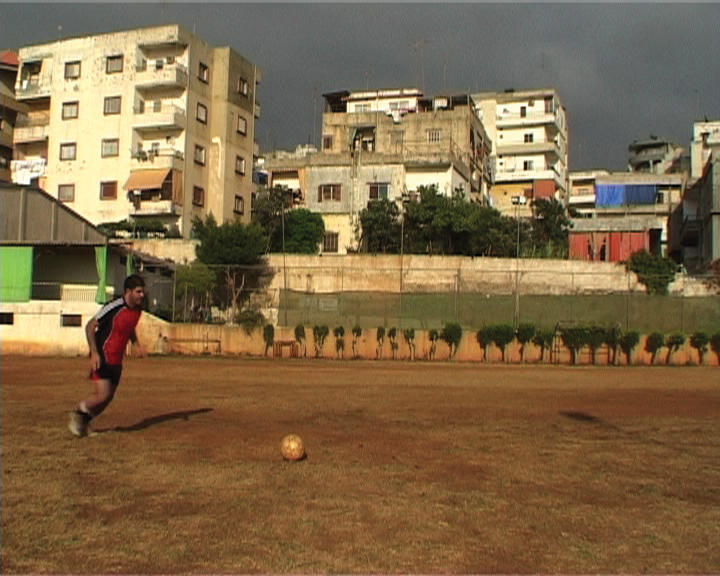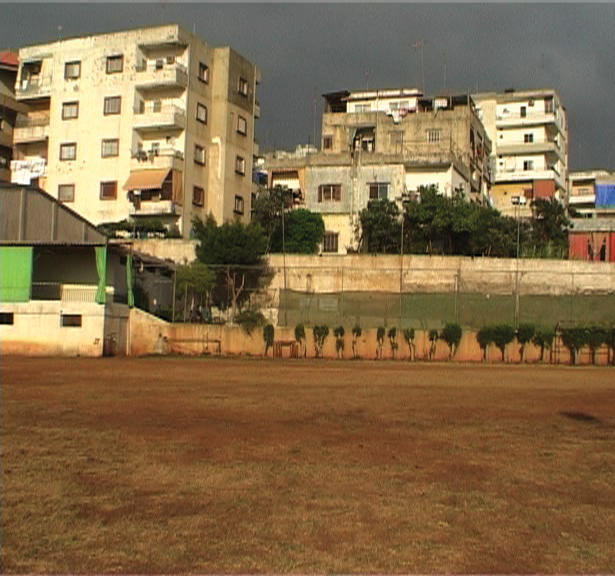
Ziad Antar doesn’t play football. He doesn’t even like football. He comes from a part of the world where the popularity of football surpasses that of any other organized sport (the streets of Beirut erupted in fireworks and Italian, Brazilian, French, and German flags during the last World Cup, and local teams Al-Nejmeh, Al-Ansar, and Al-Hekmeh boast fans of such fierce loyalty that the army frequently intervenes during matches lest the uproar stir sectarian strife). But football doesn’t interest Antar much. So as he sets out to make his next, as yet untitled, video set in a football stadium and featuring Al-Nejmeh players staring down the camera in a performative exercise of shooting practice, you know it’s going to be a little different.
“There is no script, and it is one sequence,” says Antar. “It is not about football. The whole idea is to create with a football team, and to experiment with something different than what we expect from a football team, [which is] challenge and confrontation. [Mine] is an anti-confrontation video. [The players] are not facing each other… They are playing for the camera… Each one is facing the camera alone with his own ball. So there is no meeting face-to-face. Why not? Total individualism. No more teams.”
Despite his lack of passion for football, Antar is aware of the formal possibilities posed by games and the highly ordered, self-contained drama of sport. With winners and losers and tactical moves, sport transposed into art might seem an obvious allegory. Aren’t there, after all, political implications to total individualism and no more teams? What meaning can be gleaned from a video that breaks the field of practice into its constituent parts, that depicts a spare, sequential exhibition of force (or grace, depending on the viewer’s own relationship to sport) in the service of nothing other than itself? Antar doesn’t belabor critical explanations or theoretical supports. “Whenever you pose your camera, you create a point of view,” he says. “That’s politics… My videos are not a document, nor [are they] a happening… There is always a performer.”
Antar’s football film is poised to conclude a quasi-historical arc that began with fellow artist Mahmoud Hojeij’s first video Once, from 1997, which poignantly dwelled on a young, bespectacled boy playing football on his own and dreaming of the future. Later, in the uproarious We Will Win: The Arab-Israeli Conflict in Eight Minutes, from 2006, Hojeii cast Antar as a character engaged in a round of leapfrog with two Israeli actors on an urban basketball court. The game degenerates into boyish foolishness and adolescent provocation as the three men alternately insult each other’s manhood and gather for group hugs. More than once, the director abandons his post behind a tripod-mounted camera to intervene. No one wins in We Will Win. Like its ongoing geopolitical referent, the game is inherently unstable, crumbling under the weight of its players’ self-interest.

Antar, who divides his time between Paris and his native Saida, a port city in Southern Lebanon, was recently lauded as someone to watch among a new generation of French talent. Centre Pompidou curator Christine Macel, writing in the pages of Flash Art, rather wincingly announced the era of Young French Artists in search of Charles Saatchi, à la française. According to Macel, these are the artists most likely to match the stature of Pierre Huyghe, Philippe Parreno, and Dominique Gonzalez-Foerster.
But Antar is also the perfect poster child for Lebanon’s postwar experimental video scene, the recent critical history of which has been the subject of exhibition catalogues, curatorial statements, and even doctoral dissertations. That scene was triggered by a number of key moments that have since taken on the gloss of nostalgia and the shimmer of myth.
One was the return to Beirut of Jayce Salloum and Walid Raad with six video cameras and a mobile editing suite. Another was the early iterations of the Ayloul Festival, defunct since 2001. Yet another was the Tuesday night discussions that eventually yielded Group Tuesday, a collective made up of Walid Sadek, Bilal Khbeiz, and Fadi Abdallah. Another still was Hojeij’s and Akram Zaatari’s 2001 Transit Visa project, which-among other achievements toward activating a homegrown critical art scene in the absence of any proper art schools or official institutions for contemporary cultural production-launched Antar’s career (he studied agricultural engineering in college). Antar turned up for a workshop, where he made a three-minute piece on assignment. The experience, he says, established all of the parameters of his vision and shaped every work he has made since.

Yet Antar’s work diverges sharply from that of his Beiruti peers. There’s no blurring between fact and fiction, little fascination with archives and documents, and zero obsessing over engagements with memory and history. No artist in Lebanon is creating video pieces as unfettered by context as Antar, and very few are as concerned with the actual codes of video as a visual language.
Antar’s works, from Wa and Tambourro (both 2004) to Mdardara and Tank You (both 2007), are sharp, compact, and precise-imagine Henri Cartier-Bresson’s “decisive moment” stretched out over a few judicious minutes. There are no gimmicks or tricks. In Wa, two children sing along to a synthesizer. In Tambourro, a man in the shower (the artist in fact) slaps out a beat on his chest. In Mdardara, which was shot on luscious Super 8 film, two hands (also the artist’s) barely infringe on the frame as the famed Levantine dish is prepared. Then a plastic hen hobbles into view to peck at the rice and lentils. In Tank You, a woman waits in line for gas during the siege of Lebanon in 2006. A frantic and frustrated crowd has gathered, yet the woman speaks breezily with the filmmaker. Her tank is full; she just wants to talk. It all sounds woefully simple, yet that is exactly what sets Antar’s work apart.
With any piece, he says, “I try to make it short. It is a reflection, and it should be done in very few sequences.“ Video may be easy, he adds, but the language, in his eyes, is quite restricted. It demands that one try, fail, and try again. For the football work, Antar shot a version in Saida as a practice run (the field where Al-Nejmeh plays had been damaged by a bomb blast, fallout from one in a long line of political assassinations). He placed the camera perpendicular to the players’ range of motion, so they entered from the left side of the frame, shot, and exited to the right. But the field was wrong, the shadows were wrong, and the way the players responded to the camera was wrong. A remake is in the works. “There are a lot of limitations,” Antar says. Those limitations are crucial rather than detrimental. “The ease of the video camera means one risks using video for cinematography, and that’s a mistake. I don’t use narration. I don’t capture moments. I think that art is just in front of me. How to translate it into video is the challenge. If I were to define it,” he says, “I would say I witness with some manipulation.”